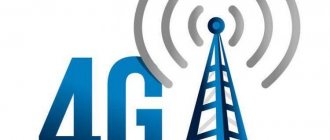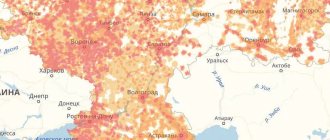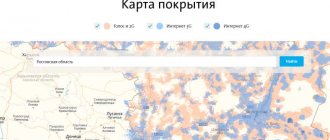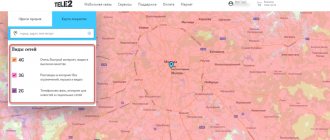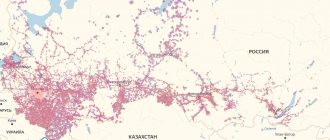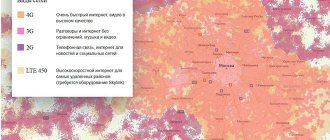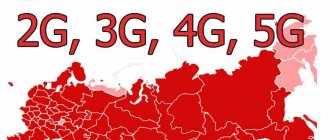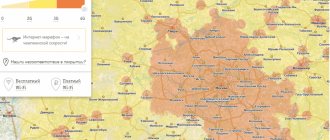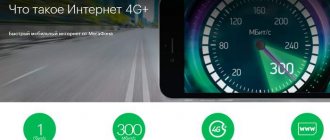Telecommunications operators try to tell subscribers in detail about current tariff plans, discounts and bonuses, available technologies and current coverage areas.
Rostelecom is no exception: the official website provides information about services and prices, as well as where there will be no problems with connecting to the Internet, wireless Wi-Fi points and 3G and 4G mobile networks. In addition to the official source, statistics generated by statistical services are also presented.
Types of cards
In the case of Rostelecom, we can distinguish 2 coverage maps for different directions. These are mobile communications and free Wi-Fi hotspots in cities. Let's consider each option separately.
Wi-Fi Internet coverage area
Rostelecom. Access pointWi-Fi hot spot in the Nizhny Novgorod region
One of the excellent solutions of PJSC Rostelecom is the creation of a network of collective access points for clients. Anyone can connect to them for free and enjoy access to broadband Internet. Such points are located in different locations throughout the country.
You can connect from any gadget that supports Wi-Fi technology. It is worth noting that authorization is required. This happens via SMS, call or through the State Services portal.
Mobile network coverage area
Link to map: https://rt.ru/map_mvno
On the mobile services page on the company’s official website you can see an interactive coverage map. It is equipped with the following functions:
- search by city, street, metro station;
- scaling (zoom in or out);
- set filters to display zones based on certain technologies (2G, 3G, 4G).
It is noteworthy that Rostelecom’s coverage area coincides with Tele2.
Mobile network coverage area
With the 2G, 3G and 4G coverage area, things are similar - the operator explains in detail what technologies are available in which regions, and at the same time even provides speed statistics on average for the country. The information is interesting, but only in 50% of cases is it close to the truth. This is all due to the testing method: statistical information is collected mainly in an “ideal environment”, when the towers are without additional load, the weather conditions are stable, and the landscape is without sharp ascents and descents (and the signal is not interrupted by unexpected obstacles and high-rise buildings).
What is indicated on the coverage map of the Rostelecom operator
The interactive coverage map is a regular map where all regions, cities, streets, and so on are located. However, colored zones are applied to it, indicating the presence of coating, as well as its quality in this place. Each color is responsible for its own service technology.
- dark purple - 2G;
- light purple - 3G;
- orange - 4G.
It is important to note that 2G services are not provided in Moscow and the Moscow region. Therefore, to use services in this area, you must have a 3G or 4G enabled device.
Broadcast types
Even though Rostelecom covers almost all of Russia, in its coverage area there is also a very arbitrary division into the types of available broadcasting. The speed of your Internet connection and the ability to use mobile communications depend on the type. As a rule, the largest number of Rostelecom stations are located in cities or their environs. A little further, and interference may occur, and the network may not even be detected as 3G.
In addition, there are also empty zones in the coverage area - they can arise both near Rostelecom stations due to the method of their transmission, and in the outback, at the greatest distance, which is logical.
Rostelecom's currently available broadcast types include:
- 4G – high speeds and very little interference. Most cities have 4G coverage - this means that you can safely use not only the Internet, but also regular communications (calls, SMS). Coverage is constantly expanding to cover more and more territory - there is a high demand due to truly fast connection speeds.
- 3G is also a high-speed connection. More widespread than 4G. The coverage area can even include small settlements.
- 2G – normal connection, slow connection. The most basic type for many operators. The Internet coverage area is small, but mobile communications in this range work everywhere.
You can find the broadcast type designation on your smartphone, even just by walking around the city. Some areas will have 4G coverage, while others will barely support 2G. This depends on the location of Rostelecom equipment and towers, but the chance of constant use of high-speed network access in cities is much greater than in remote areas of the country.
What to do if the Internet connection is poor
In most cases, poor communication is not due to a lack of coverage in a certain area, but to problems with the user's device itself. If you have checked the coverage area and are sure that there is a good connection, it is recommended to use the following tips:
- reboot your device;
- switch to other modes of mobile signal operation;
- use an additional antenna to improve the signal;
- check if the traffic package on your tariff has expired. Indeed, in this case, the Internet speed is reduced;
- Perhaps you are deep in a room where there is a lot of interference with a high-quality signal;
- file a complaint about the quality of services provided.
How to check if there is Rostelecom coverage
The only more or less reliable way to find out whether Rostelecom will “take” it at your chosen point is in practice:
- Buy a Rostelecom SIM card and activate it.
- Get to a place that interests you.
- Check if you can open pages on the Internet or call someone. The tray will also display the current connection type.
Important! Since the signal distribution does not occur linearly or evenly, be prepared that the connection may either be lost or significantly deteriorate in quality if you return to the same place the next day. There are too many factors affecting the signal level.
Rostelecom provides a fairly stable connection in all those areas where its coverage exists (sometimes these are very remote areas), but as is the case with any telecom operator, problems, sagging and lack of network may well occur. This is often not operator error, but rather interference. Some of them are capable of turning an entire section of your road into a “empty zone”, after which the network and communications return.
If you are going to go somewhere outdoors and are not sure that Rostelecom coverage is possible there, call the operator. He will check the presence of nearby towers in his database, and will be able to roughly determine whether there will be a signal or not.
How to determine the location of towers
If you definitely want to see Megafon cell towers on the map, you can download special software - there are several proven high-quality applications on the network. Why are they even needed? Users download them for different purposes:
- Users can evaluate the actual coverage area of the operator;
- You can easily find free wireless network sources;
- To find out whether your operator will work in a certain location;
- In order to understand how stable the tower signal is - are there any failures or irregularities in operation;
- When purchasing wireless routers, you need to know which way to point the antennas to catch the signal;
- Radio amateurs will be able to determine how much interference there is - and whether there is any at all;
- Often, data is used when choosing housing - after all, everyone needs high-speed and constant access to the network, as well as a stable signal for communication;
- The information is also used during rescue operations - in some corners there are no towers, it is necessary to install special equipment to catch the signal.
- OpenSignal;
- Cellulailer;
- Cellumap;
- Network Signal Info;
- Connection quality;
- Cell Coverage Map;
- netmonitor;
- Network Cell Info.
Let's try to search for the nearest Megafon tower in the OpenSignal application:
- Download the program and open it, make sure you are connected to the Internet;
- The interactive coverage will load automatically;
- You will see markings by zones - the colors correspond to the quality level;
- Click on the nearest tower of any operator, marked with a special icon;
- Detailed speed and quality data will open.
Together we looked for Megafon base stations on the map, figured out equipment identification and learned to find signal sources through a mobile application. Agree, it’s interesting to know how our gadgets work, where does the connection come from?
4G coverage from Rostelecom
4G technology has been used by the provider since 2014. At the moment the coverage is not that global. Current information about 4G Internet is available on the operator’s official website. The map shows that not all regions of the country are provided with a high-speed network. There is no fourth generation network in the North Caucasus, including the Stavropol Territory, Astrakhan, Samara regions, and the Republic of Bashkortostan. Almost immediately after the installation of the first LTE repeaters, RT signed an agreement with Tele2. Perhaps the installation of equipment that provides 4G should be handled by Tele2. Information about access to the 4th generation network should be clarified at the provider’s call center at the time of connection by calling 88001000800.
How to connect to RTWiFi from a smartphone or tablet
You will have to spend literally 1 minute of time on this procedure:
- Every modern mobile device has a “Settings” section. Through it you need to open the category with Wi-Fi access points. The category may be called "WLAN", specifically "Wi-Fi". It all depends on the device model;
- In the list of points that opens, select RTWiFi;
- Two columns will appear. In one we indicate the login, in the second - the password. We described above where to get this data;
- Confirm that you accept the certificate (this is a formality);
- At the top of the display, where the time and device charge level are usually indicated, a Wi-Fi icon will appear, confirming that you are connected to the Internet.
Now you can use the Internet not only through the built-in browser of your smartphone or tablet, but in social networking applications, etc.
Tariffs for Internet use
Rostelecom's mobile communications costs largely depend on the current tariff plan. Rostelecom has a huge product line; you can choose per-megabyte pricing or unlimited with payment at the end of the month.
Checking the possibility of Rostelecom Internet connection at a specific address
Tariff plans for mobile Internet from Rostelecom are described below:
- Internet with you. There is a flat rate of 4 rubles. in a day. In return, the operator provides you with 70 MB/day;
- Extend the speed - this is an additional option, it gives you another 60 MB. Product activation will cost you 10 rubles;
- Easy Internet per megabyte payment. The cost of 1 MB is 1 rub. This service is suitable for those who occasionally visit the World Wide Web to check email or download a small file. You can activate the service for free the first time, but then the procedure will cost 10 rubles;
- For more active users there are tariffs of 3-25 GB. With this traffic, you will be able to download a movie or audio files. The price of such tariff packages varies from 125 to 400 rubles.
A detailed description of all current offers can be found on the RT.ru website.
How to connect to RTWiFi from a Windows computer
In this case, you need to spend a little more time connecting. But if you know how to use a personal computer, the instructions will seem elementary to you:
- Go to the "Network and Sharing Center" section. The operating system has a function to search for partitions by name. You can use it if you don’t know where this category is. After opening ;
- Click on the function to add a new network. It is important to indicate that you want to form the network manually - that is, yourself;
- Now, the most important thing is not to make mistakes in filling out the fields:
- Network name - RTWiFi (no spaces, only in English letters, please use capital and lowercase letters)
- Security type: WPA2-Enterprise
- Encryption type: AES
- Other items: No adjustments should be made.
- Click on the “Next” button. Here you will be able to change connection settings. Select this item;
- Go to the “Security” section;
- The way the network is authenticated is important. You should stop at the item “Microsoft: Protected EAP (PEAP)”;
- Now click on the “Options” item. In the window that opens, go to “Configure”;
- If you see that the checkbox next to “Use Windows login and password automatically” is enabled, uncheck it;
- Confirm your actions by clicking the “OK” button.
- Open the additional settings section. parameters;
- There will be a column associated with the authentication mode. In the list you need to stop at “User Authentication”;
- Don't forget to save your credentials;
- Now you are required to have a login and password to gain access to the Internet from your provider;
- After entering two data, click on the “OK” button. You no longer need open windows.
How they work
How does a standard base station work? In a nutshell, your SIM card receives the signal issued by the nearest tower, thereby providing you with various communication services - the ability to make calls, receive and send SMS messages, and mobile data transfer. When a person moves with the phone turned on, the device will invariably receive a signal from the nearest tower, that is, switch between them. This way the connection will always be good. The exception is when something interferes with the signal - for example, you are in a basement where no additional equipment is installed, or you have gone out of town and the nearest station is quite far from you.
How to connect to Wi-Fi from Rostelecom in villages and towns
You must understand that such technologies today are in the beta testing phase. That is, the service is just being formed. Therefore, sometimes citizens encounter communication errors. Sometimes the error lasts even a week. This is normal, as technical work is underway to make the Internet connection more stable.
We strongly recommend that you do not refuse to purchase a home access point or router. Without getting too technical, your internet connection will simply get better. A common antenna will provide a better signal.
However, you can't always blame the provider for the lack of internet in the province. Sometimes users make mistakes when connecting a device to the network. To avoid having to connect several times, we offer you detailed instructions that allow you to connect to RTWiFi from both a computer, a smartphone, and a tablet computer.
State program
The state program, initiated by the government in 2014, was designed to eliminate the so-called digital divide. Rostelecom, as the oldest provider providing communications to most government agencies and projects, was entrusted with this task. Today, Rostelecom is the only company in the Russian Federation that is eliminating the digital divide.
To achieve this, the company decided to install a fiber-optic digital line to each individual village or town, the bandwidth of which was calculated based on the population. After this, a switch is installed that implements an access point for users. The Internet is distributed from it using an antenna (Wi-Fi network) and/or through connecting and running cables to each specific house with the implementation of additional access points (rare and expensive - in agreement with the village administration and residents).
At the moment, in most regions, Wi-Fi network protocols are used, which allow subscribers to use several types of access to the worldwide network.
Connectivity
Progress does not stand still, so villages and remote towns began to actively connect to the Internet back in 2014. Until this time, residents did not have many options:
- Some houses with a telephone line used dial-up Internet services, which have practically died out in all cities.
- Others preferred to use mobile Internet, connecting via 3G and 4G modems - unfortunately, in some localities this is still the only available option.
- The most enterprising residents turned to provider companies directly, willing to pay out of their own pockets for the installation of fiber optics and leased lines to each home, but the projects were extremely costly and many simply did not have such funds.
All these methods were and remain too expensive or provide very slow speeds, not to mention the fact that in some remote corners of our country sometimes even mobile communications cannot be received. Therefore, the State Program came to the aid of thousands of residents.

